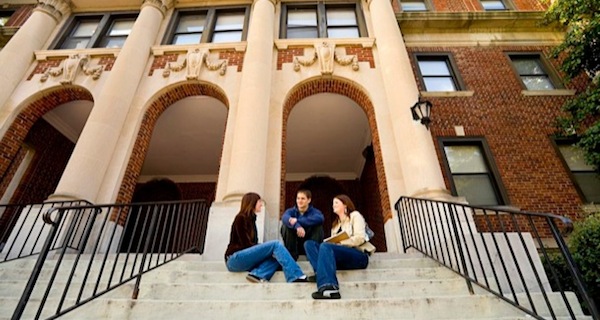How to Optimize Cell Broadcast for Higher Ed Emergencies

Colleges and universities often utilize digital signage as a way to mitigate a safety problem: the majority of faculty, staff, and students who don’t register their cell phone numbers so the school can send emergency alerts via text messages. An extensive signage network also helps provide instant updates for those who have registered but cannot receive SMS messages because cellular networks often get overloaded during emergencies.
Cell Broadcast provides a third option, one that’s more reliable and comprehensive than text messaging or digital signage. Here’s how it works—and how to add it to your portfolio of emergency-alert tools on campus.
Also known as Wireless Emergency Alerts (WEA), Cell Broadcast technology sends an alert to phones in a geographic area, such as a college campus, the immediate area surrounding the campus, a metropolitan area or the entire country.
The alert goes to phones served by participating mobile operators, which include majors such as AT&T, Sprint, T-Mobile and Verizon Wireless.
WEA ADOPTION ON CAMPUS
Not all mobile phones currently support WEA, but many do, and the number is growing.
“The majority of phones released in the past couple of years have the WEA capability,” says Brian Josef, assistant vice president of regulatory affairs at CTIA, a mobile industry trade association. “For example, one carrier said that every phone they’ve marketed in the past two years have been WEA capable.”
Operators typically publish lists of their WEA-ready phones, such as support.verizonwireless.com. It also helps that college students upgrade their phones frequently, increasing the likelihood that they’ve long since replaced an old one with a WEA-ready model.
A daily selection of features, industry news, and analysis for tech managers. Sign up below.
If the phone and operator both support WEA, it doesn’t matter whether that customer has prepaid or postpaid service, or whether she has signed up for text messaging or data service. Either way, the alert goes out to that phone. Ditto for people roaming in that area, such as parents dropping off their teenagers at the start of the academic year.
When people buy a WEA-ready device, they’re automatically enrolled to receive alerts. That eliminates the problem of low participation – and thus limited effectiveness during emergencies – that comes when people don’t know about the technology. Most don’t, partly because WEA is a relatively new technology. They can opt out later on, but lack of awareness actually helps in that regard because they won’t enroll from something they don’t know exists.
Depending on the phone, WEA messages might appear in a format that looks like a text message, but they use a separate, dedicated network channel and a completely different technology. As a result, WEA messages aren’t vulnerable to network overloading the way text messages are.
THREE ALERT CLASSES
WEA has three alert classes: presidential, which is for events that affect large portions of the country; imminent, for more local events such as a tornado or a shooter on campus; and Amber alerts.
Alerts are limited to 90 characters. WEA sometimes is referred to as a “bell-ringer” technology, meaning it’s designed to wake up people rather than stand in for the school’s Twitter feed.
WEA is for serious—often life-or-death—events. For example, it can’t be used to let town and gown know that a street will be closed for a pep rally.
Colleges and universities must issue alerts through a government agency—such as a county or city emergency management agency—rather than sending them directly to mobile operators. That agency then sends the alert to FEMA, which issues it to participating operators in that area.
WEA, FEMA, & STATE AGENCIES
Many cities and counties have not yet been authorized to send WEAs to FEMA. If your school is in one of those communities, you still can send alerts via a state agency. For a list of authorized agencies, see fema.gov.
The alert includes geographic codes that tell each mobile operator which area should get the alert. The operator has those codes mapped to its cell sites, so the alert is broadcast only from those cell sites covering that area.
How should a school calculate each alert’s geographic scope? The definitive answer is, it depends. For example, a spill of radioactive material in a lab probably should be limited to the campus and maybe the immediate surrounding area. But a shooter probably justifies alerting the entire community — and not just because of the severity. “They may want to have a broader coverage area so faculty and students driving to the campus are warned not to proceed,” Josef says. “The Virginia Tech shooting, for example, if people knew not to enter the incident zone on campus, that would have accomplished a lot.”
Tim Kridel is a regular contributor to AV Technology Magazine.
